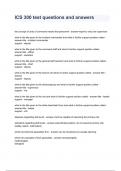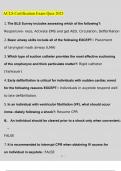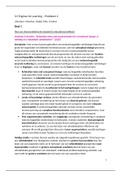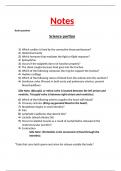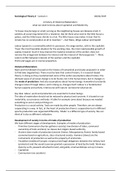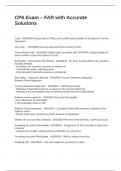▪ Fick’s Law • Gas exchange ~ is the uptake of molecular O2 from
▪ Air and water breathing the environment and the discharge of CO2 to the
▪ Another example of Counter-current exchange environment.
▪ Comparison of mammals and birds • The transfer of gases takes place in several stages:
▪ Control of ventilation 1. Breathing movements which ensure a
▪ The exchange process and transport in blood continuous
▪ Dissociation curves supply of air or water to the respiratory surface
▪ Special cases: pregnancy; diving, altitude 2. Diffusion of O2 and CO2 across the respiratory
epithelium
Gas exchange occurs across specialized 3. Bulk transport of gases by the blood
respiratory surfaces 4. Diffusion of O2 and CO2 across capillary walls
between blood and the cells of tissues.
▪ Fick’s Law
M=
DA a1 − a2 Solution of gases in water:
X → All respiratory epithelia must be kept moist.
• M = rate of transfer → Gases must be dissolved in water to be taken up by
• D = diffusion coefficient the cells.
• A = area → This can be a problem in terrestrial animals,
• a1 − a2 = concentration gradient especially in hot, dry environments.
• X = diffusion area Solubility of gases in water depends on several
factors:
• the solubility of the gas
• the partial pressure of the gas
• solubility decreases with increased temperature
• comes into equilibrium faster at higher temperatures
• solutes - solutes decrease the solubility of gases
Partial Pressure Gradients in gas exchange
→ Partial pressure~ the pressure exerted by a
particular gas in a mixture of gases
→ A gas always undergoes net diffusion from a region
Respiratory Media of higher partial pressure to a region of lower
→ Conditions for gas exchange vary considerably, partial pressure.
depending on whether the respiratory medium, → Determining the partial pressure can help us find
the source of O2 , is air or water. the net movement of gas at an exchange surface
→ Air is much less dense and less viscous than → To calculate partial pressures, we need to know the
water, so it is easier to move and to force pressure that a gas mixture exerts and the fraction
through small passageways. ~ easy & efficient of the mixture represented by a particular gas.
→ Water is a much more demanding gas exchange → Partial pressures also apply to gases dissolved in a
medium than air. liquid, such as water.
→ The amount of O2 dissolved in a given volume → When water is exposed to air, an equilibrium state is
of water varies but is always less than in an reached such that the partial pressure of each gas
equivalent volume of air. in the water equals the partial pressure of that gas
→ Water’s lower O2 content, greater density, and in the air.
greater viscosity mean that aquatic animals → The concentrations of O2 in the air and water differ
such as fishes and lobsters must expend substantially because O2 is much less soluble in
considerable energy to carry out gas exchange water than in air
, Respiratory Surfaces
→ The cells that carry out gas exchange have a plasma membrane that must be in contact with an aqueous
solution.
→ Respiratory surfaces are therefore always moist.
→ The movement of O2 and CO2 across respiratory surfaces takes place by diffusion.
→ The rate of diffusion is proportional to the surface area across which it occurs and inversely proportional to
the square of the distance through which molecules must move.
→ So, gas exchange is fast when the area for diffusion is large and the path for diffusion is short.
→ Therefore respiratory surfaces tend to be large and thin.
→ In some simple animals, such as sponges, cnidarians, and flatworms, every cell in the body is close enough
to the external environment that gases can diffuse quickly between any cell and the environment.
→ In many animals, the bulk of the body’s cells lack immediate access to the environment.
→ The respiratory surface in these animals is a thin, moist epithelium that constitutes a respiratory organ.
→ For earthworms, as well as some amphibians and other animals, the skin serves as a respiratory organ.
→ A dense network of capillaries just below the skin facilitates the exchange of gases between the
circulatory system and the environment.
→ For most animals, however, the general body surface lacks sufficient area to exchange gases for the whole
organism.
→ The evolutionary solution to this limitation is a respiratory organ that is extensively folded or
branched, thereby enlarging the available surface area for gas exchange.
→ Gills, tracheae, and lungs are such organs.
1 Gills in Aquatic Animals
→ Gills~ are outfoldings of the body surface that are
suspended in the water.
→ Gills often have a total surface area much greater than
that of the rest of the body’s exterior.
→ Movement of the respiratory medium over the
respiratory surface, a process called ~ ventilation,
→ This maintains the partial pressure gradients of O2 and
CO2 across the gill that are necessary for gas
exchange.
→ To promote ventilation, most gill-bearing animals either
move their gills through the water or move water over
their gills.


